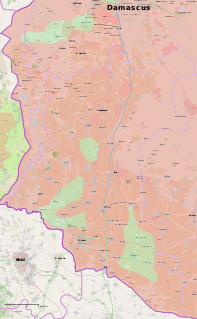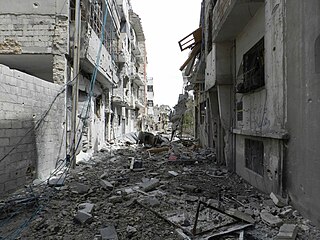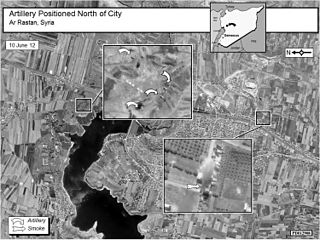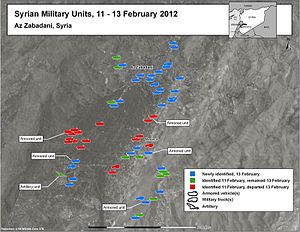
The Free Syrian Army (FSA) is a loose faction in the Syrian Civil War founded on 29 July 2011 by officers of the Syrian Armed Forces whose goal is to bring down the government of Bashar al-Assad. A formal organization at its founding, its structure gradually dissipated by late 2012, and the FSA identity has since been used by various opposition groups.

The siege of Homs was a military confrontation between the Syrian military and the Syrian opposition in the city of Homs, a major rebel stronghold during the Syrian Civil War. The siege lasted three years from May 2011 to May 2014, and resulted in an opposition withdrawal from the city.

The 2011–2013 Daraa Governorate clashes are a series of military confrontations between the Syrian Army and the Free Syrian Army in Daraa Governorate, Syria, which began in November 2011, after widescale protests and crackdown on protesters in Daraa had lasted since April 2011. The clashes had been ongoing as part of the Syrian civil war, until the U.N. brokered cease fire came into effect on 14 April 2012. Sporadic clashes continued since then, however.
The Rif Dimashq clashes were a series of unrests and armed clashes in and around Damascus, the capital of Syria, from November 2011 until a stalemate in March 2012. The violence was part of the wider early insurgency phase of the Syrian Civil War. Large pro-government and anti-government protests took place in the suburbs and center of Damascus, with the situation escalating when members of the Free Syrian Army (FSA) started attacking military targets in November.

The September 2011 – March 2012 Idlib Governorate clashes were the violent incidents that took place in Idlib Governorate, a province of Syria, from September 2011 and prior to the April 2012 Idlib Governorate Operation.
The following is a timeline of the Syrian Civil War from January to April 2012, during which time the spate of protests that began in January 2011 lasted into another calendar year. An Arab League monitoring mission ended in failure as Syrian troops and anti-government militants continued to do battle across the country and the Syrian government prevented foreign observers from touring active battlefields, including besieged opposition strongholds. A United Nations-backed ceasefire brokered by special envoy Kofi Annan met a similar fate, with unarmed UN peacekeepers' movements tightly controlled by the government and fighting.
The Battle of Douma was a military engagement during the Syrian Civil War. The battle began on 21 January 2012, after Free Syrian Army fighters changed their tactics from attack and retreat guerrilla warfare in the suburbs of Damascus to all-out assault on army units. Earlier in January, the FSA had taken the town of Zabadani, and consequently gained control over large portions of Douma. After a general offensive in the suburbs, Douma was retaken by the Syrian army at the same time as the other rebelling suburbs.

A second battle between the Syrian Army and the Free Syrian Army for control of the city of Rastan took place from 29 January to 5 February 2012. Located in Homs Governorate, Rastan is a city of 60,000 residents. The FSA captured Rastan after days of intense fighting, according to residents and the opposition.

The 2012 Homs offensive was a Syrian Army offensive on the armed rebellion stronghold of Homs, within the scope of the Siege of Homs, beginning in early February 2012 and ending with the U.N. brokered cease fire on 14 April 2012.

The first of the two battles in al-Qusayr was fought by the Syrian army and Shabiha against the Free Syrian Army in the small city of Al-Qusayr, near Homs, during late winter and spring of 2012.

The Battle of Idlib was a battle that was fought in the city of Idlib, located in the north of Syria, starting on 10 March 2012. The battle took place in a province considered a stronghold of the armed opposition to the Syrian government and was fought in the wider context of the Syrian Army trying to retake several rebel strongholds. After three days of fighting, the Syrian Army recaptured the city.
The Hama Governorate clashes were a series of incidents of fighting during late 2011 and early 2012 in the Syrian Governorate of Hama, as part of the Early insurgency phase of the Syrian Civil War.

The Battle of Rastan between the Syrian Armed Forces and the Free Syrian Army took place in the city of Rastan on 14 May 2012, during the U.N. brokered cease-fire of the Syrian uprising.

The Battle of Damascus, also known as Operation Damascus Volcano, started on 15 July 2012 during the Syrian civil war. It is unclear who started the battle. Thousands of rebels infiltrated Damascus from the surrounding countryside. Following this, according to some reports, the opposition forces launched an operation to capture the capital, while according to other reports, the military learned of the large-scale rebel operation beforehand and made a preemptive strike. Some reports even suggested the rebels launched the operation prematurely due to their plans being discovered by the security forces.

The siege of Wadi Deif refers to the siege of two Syrian Army bases, Wadi Deif and Hamadiyah, by rebel forces, starting on 11 October 2012, during the Idlib Governorate clashes of the Syrian civil war.

The al-Qusayr offensive was an operation by the Syrian Government forces against Opposition forces at al-Qusayr in Homs province, during the Syrian Civil War. The operation was launched on 4 April 2013. The Syrian Army, the Lebanese militia Hezbollah and the National Defense Forces played key roles in the attack. Its aim was to capture all villages around the rebel-held town of al-Qusayr, thus tightening the siege of the city and ultimately launching an attack on al-Qusayr itself. The region was an important supply route for rebels fighting Syrian government forces in Homs.
The second of two battles in al-Qusayr started on 19 May 2013, as part of the larger al-Qusayr offensive, launched in early April 2013 by the Syrian Army and the Lebanese militia Hezbollah, during the Syrian civil war, with the aim of capturing the villages around the rebel-held town of al-Qusayr and ultimately launching an attack on the town itself. The region was strategically important as a supply route for rebels fighting Syrian government forces in Homs and also for the Syrian government, as it lies between the capital, Damascus, and the Syrian coast, a stronghold for Assad supporters.

The Battle of Zabadani (2015) started in early July 2015, during the Syrian Civil War, as a military offensive launched by the Syrian Army, and Hezbollah to capture the rebel-held town of Al-Zabadani.
The following is a timeline of the Syrian Civil War from August to December 2015. Information about aggregated casualty counts is found at Casualties of the Syrian Civil War.

The early insurgency phase of the Syrian Civil War lasted from late July 2011 to April 2012, and was associated with the rise of armed oppositional militias across Syria and the beginning of armed rebellion against the authorities of the Syrian Arab Republic. Though armed insurrection incidents began as early as June 2011 when rebels killed 120–140 Syrian security personnel, the beginning of organized insurgency is typically marked by the formation of the Free Syrian Army (FSA) on 29 July 2011, when a group of defected officers declared the establishment of the first organized oppositional military force. Composed of defected Syrian Armed Forces personnel, the rebel army aimed to remove Bashar al-Assad and his government from power.














